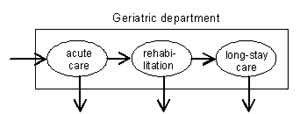Nosokinetics
A Closed Queueing Network Approach
to the Analysis of Patient Flow in Health Care Systems
Chaussalet T J, Xie H, Millard P
Methods of Information in Medicine 2006, 45:492-7(comments to rjtechne@iol.ie)
When planning bed allocation to hospital specialties, there is a clear distinction between services with constrained and unconstrained bed allocations. General medicine is a front-line, medical emergency service. "Bed borrowing" by admitting physicians shows that their bed allocation is unconstrained. Practically, therefore, general medicine has as many beds (or trolleys) as required at any time. In contrast, geriatric medicine is a secondary, community supportive, service with a fixed number of beds. And waiting lists for admission to geriatric medical beds indicate that the bed allocation is constrained. In mathematical modelling terms, a department with a fixed number of beds and operating at full capacity is said to be a 'closed' system.
Queuing network models consist of a number of server nodes each consisting of a number of servers, whose property is typically defined by the service rate (i.e. the number of requests that each server can deal with in a unit time), and the corresponding service time (i.e. the time needed for a server to finish a request), which is assumed to follow an (negative) exponential distribution.

The novelty of this approach brings models that are commonly used in other fields (such as computer network and telecommunication system) into the modelling of health care systems. As a result, it enables us to have access to a range of established methods that deal with queuing network models. More importantly, this approach provides a natural platform for incorporating a capacity constraint on the system (e.g. the total number of beds available in a department). By varying different model parameters such as bed allocation, average length-of-stay in each phase, and transfer probability between phases, clinicians and health care system managers can study 'what-if' questions related to the long-term effect of changes to the current policies.
The paper demonstrates this modelling approach in the case of a geriatric department using parameters from a North London geriatric medical service. Assuming that staff behaviour does not change, our findings support an early observation by Struthers (BMJ 1963,1:470) that improving the treatment of chronic patients is, in the long term, the best way to reduce bed blocking and to improve throughput in the department.
Although the closed system described in this paper is reasonable for health care systems with constrained bed allocations and waiting lists for admission (such as geriatric medicine) its applicability in other specialities may be limited. Further work is ongoing to extend this approach to 'semi-open' systems, i.e. a department with a constrained bed capacity which will remain open if there is an empty bed available, and is closed if full capacity is reached - which provides a more realistic representation to the running of a department.
Some navigational notes:
A highlighted number may bring up a footnote or a reference. A highlighted word hotlinks to another document (chapter, appendix, table of contents, whatever). In general, if you click on the 'Back' button it will bring to to the point of departure in the document from which you came.Copyright (c)Roy Johnston, Ray Millard, 2005, for e-version; content is author's copyright,